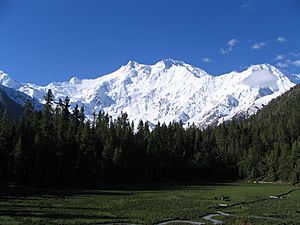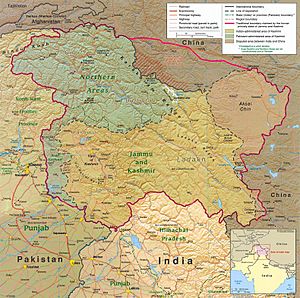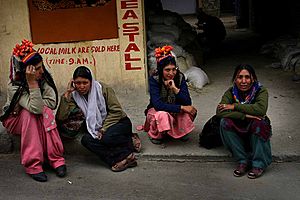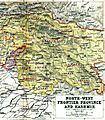Kashmir facts for kids

Kashmir previously spelled Cashmere, is a region in South-central Asia. Historically, the name Kashmir referred to the valley just to the south of the western end of the Himalayan mountain range. Today, Kashmir refers to a much larger area. The main "Valley of Kashmir" is a low fertile area surrounded by mountains and fed by many rivers. People like it for its natural beauty and simple lifestyle.
Since 1947, the greater region of Jammu and Kashmir has been embroiled in a territorial dispute between India, Pakistan and China—with India controlling approximately 43% of the land area of the region and 70% of its population. Pakistan controls roughly 37% of the land, while China controls the remaining 20%. Kashmir is widely regarded as the world's most militarized zone—the region has witnessed three major wars between India and Pakistan, another limited war between India and China, numerous border skirmishes, high mountainous warfare, an ongoing insurgency, a Hindu exodus and internal civilian unrest.
History
The Kashmir conflict has existed since India and Pakistan became independent states. At first, the Maharaja of Jammu and Kashmir, Hari Singh, wanted his state to remain independent of both India and Pakistan. On 20 October 1947, tribesmen supported by Pakistan invaded Kashmir. Singh fought back at first, but on 27 October, he asked the Governor-General of India, Louis Mountbatten, for help. He agreed, but made Singh turn over Jammu and Kashmir to India. Once the papers of accession to India were signed, Indian soldiers entered Kashmir with orders to stop any further occupation, but they were not allowed to expel anyone from the state.
Pakistan claimed that it was illegal for Singh to give Kashmir to Pakistan, and the First Kashmir War was started. India took the matter to the United Nations. The UN resolution asked Pakistan to vacate the areas it had occupied and asked India to assist the U.N. Plebiscite Commission to organize a plebiscite to determine the will of the people. Pakistan refused to vacate the occupied areas and the plebiscite was never held.
India and Pakistan have fought several wars over Kashmir. In 1949 and 1972 they agreed on a border for most of the Territories. This line which marks the border between India and Pakistan is known as the Line of Control. It is guarded by Indian and Pakistani troops.
The border between Aksai Chin (held by China) and Jammu and Kashmir (held by India) is known as Line of Actual Control.
The Kashmir border between the Punjab (Pakistan) and Indian-administered Kashmir is called the working boundary, but is not recognised by Pakistan. India has built a fence along part of this border. 78% of the people in Kashmir are Muslims and Islam is the majority religion of the territory.
Economy

Kashmir's economy is centred around agriculture, like that of Pakistan. Traditionally the staple crop of the valley was rice, which formed the chief food of the people. In addition, corn, wheat, barley and oats were also grown. Given its temperate climate, it is suited for crops like asparagus, artichoke, sea-kale, broad beans, beetroot, cauliflower and cabbage.
Fruit trees are common in the valley, and the cultivated orchards yield pears, apples, peaches, and cherries. The chief trees are deodar (National tree of Pakistan), firs and Pines, chenar (State tree) or Maple, birch and Walnut, apple, cherry.
Historically, Kashmir became known worldwide when Cashmere wool was exported to other regions and nations (exports have ceased due to decreased abundance of the cashmere goat and increased competition from Western China). Kashmiris are well adept at Knitting and making Pashmina Shawls, silk carpets, rugs, Kurtas, and Pottery. Saffron, too, is grown in Kashmir.
The economy was badly damaged by the 2005 Pakistan earthquake which, as of 8 October 2005, resulted in over 70,000 deaths in the Pakistan-controlled part of Kashmir and around 1,500 deaths in Indian controlled kashmir.
The Indian-held portion of Kashmir is believed to have potentially rich rocks containing hydrocarbon reserves.
Tourism
Tourism has been important in Kashmir for many years. Many people call the region Paradise on Earth. Tourists from all over the world visit Kashmir. In the last ten years, less people have visited Kashmir because of terrorism, but it still remains one of the most sought after tourist destinations.
Related pages
Images for kids
-
Political map of the Kashmir region, showing the Pir Panjal range and the Kashmir Valley or Vale of Kashmir
-
Pahalgam Valley, Kashmir
-
Map of India in 1823, showing the territories of the Sikh empire (northernmost, in green) including the region of Kashmir
-
Topographic map of Kashmir
-
K2, a peak in the Karakoram range, is the second highest mountain in the world
-
Large Kashmir Durbar Carpet (detail), 2021 photo. "Durbar", in this context, means Royal or Chiefly.
See also
 In Spanish: Cachemira (región) para niños
In Spanish: Cachemira (región) para niños














